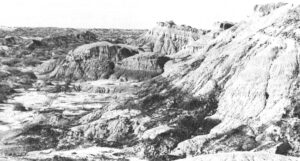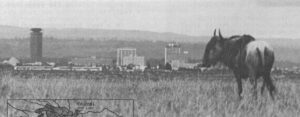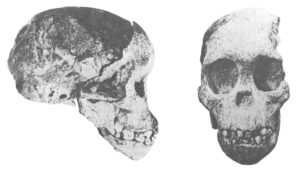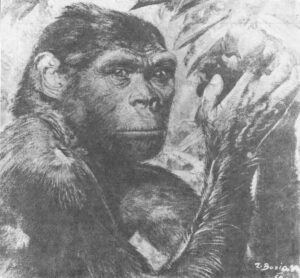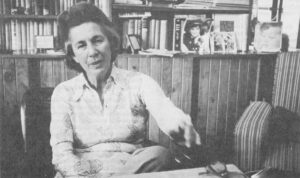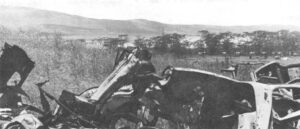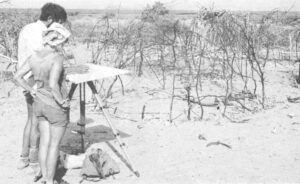The Omo Valley, Ethiopia
Out here in a remote corner of Ethiopia, under the burning African sun, they are learning what the world was like when man was born. Near the banks of the ancient Omo River, unlike any other place in the world, uplifting of the earth’s crust and subsequent erosion has fanned out the layers of geologic history so that it is possible to walk in a day through three million years of human evolution – the critical span from about 1. 5 million years ago to nearly 4.5 million years ago.
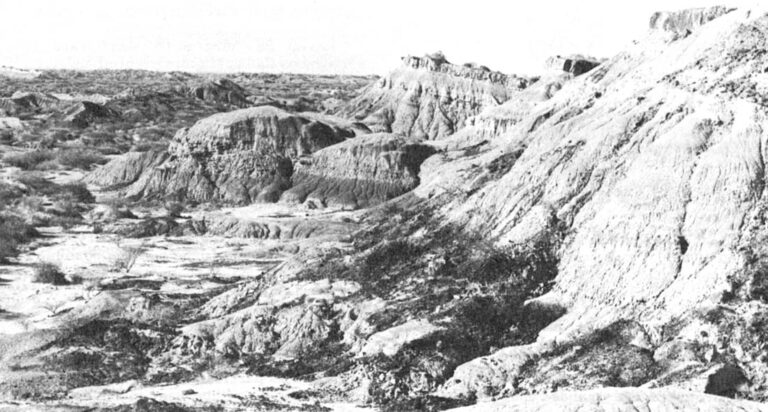
It was during this period that two legged, apelike but manlike creatures walked the grassy savannas of eastern Africa and, under the pressures of changing environmental conditions that demanded new techniques of survival, evolved into human beings.
Every summer for the past seven years expeditions of up to a dozen American, French and Belgian scientists and 30 to 40 African field workers have been camping in the Omo valley, using a variety of methods to find clues that may explain how, in effect the environment shaped man. Working largely without fanfare, the scientists have made “the Omo” one of the three most important areas in the world that have yielded pieces of the puzzle of early man’s evolution.
The most famous of the three is Olduvai Gorge in Tanzania where, just 13 years ago, Louis and Mary Leakey found the skull of an early human ancestor or hominid, that turned out to be 1.7 million years old. The anthropological world was astounded that so manlike a creature could be so old. Notions of the timetable of human evolution had to be drastically revised as scientific eyes turned from Asia to East Africa as the possible homeland of man.
Just five years ago attention turned to the second most famous of the three fossil man areas – the eastern shore of Lake Rudolf in northern Kenya. Young Richard Leakey (now 29 years old), son of the famous couple, was finding evidence of still older hominids. Just last year Leakey found an unusually large-brained hominid skull that he said was more than 2.6 million years old. The meaning of the skull and the accuracy of the suggested date remain objects of great controversy.
The least famous but perhaps the best documented of the three areas is “the Omo”. It lies just over the Ethiopian border and near the Omo River that drains into the north end of Lake Rudolf. The oldest fossil deposits in the Omo basin have turned out to be twice as old as the oldest at Olduvai and about the same as those of East Rudolf.
Above these deposits, in a virtually unbroken sequence, are successively younger layers of sediments accumulated over three million years as the seasonally flooding Omo River changed its meandering course back and forth over the plains. The bones of creatures that lived and died near the river were buried in silt and sand, in layers stacked one upon the other until the total thickness of the accumulated sediments came to some three-quarters of a mile.
Every few hundred thousand years, volcanoes far upstream erupted and the river carried millions of tons of ash downstream, depositing it on the latest sediment. Each layer of ash was, in turn, buried by still more bone-laden river sediments. Because it is possible to measure the physical and chemical properties of the ash and determine its age with great precision, fossils found between the layers of compressed and hardened ash, called tuffs can be dated with great reliability. Thus the Omo’s dozen tuffs make it possible to say, for example, that if a fossil is found between Tuff D and Tuff E, then it is between 2.12 and 2.35 million years old.
There is no other known place on land where this particular three- million- year time span – so important in the evolution of man – can be dated so accurately. Because the Omo tuffs sandwich between them rich fossil beds containing the bones of hominids and many other animals, they have attracted great scientific interest. But, because the Omo is in a hot, dry climate 400 miles from the nearest paved road, in a desolate region inhabited by warring tribes, the scientists who come to study it are a special breed. They are as skillful at snaking a Land-Rover through thick, trackless bush as they are at measuring the relative abundances of potassium and argon in ancient rocks. They are as indefatigable at digging in the 122-degree heat of midday as they are patient in piecing together the fragments of a hominid skull.
This is no ivory tower science. It is hot, dusty, sweaty, often backbreaking work. There are, in the business, many theorists who construct elaborate stories of how man might have evolved. Whether these hypotheses are true, however, is another question. It takes years of grubbing in the dust and rocks of places like the Omo and careful analysis in the laboratory to get the hard evidence that makes proof.

Understanding the evolution of man requires more than digging up fossils and arranging them in an apparent evolutionary sequence, linked with tidy theories. Herewith, a montage of some of the necessarily highly technical ways Omo scientists present their methods of analysis and findings to their colleagues. Their work in a variety of disciplines over the last seven years has cost about 750,000 dollars, most of it coming from the National Science Foundation.
Now and again a lucky paleontologist turns up a skull or a tooth that in itself says something exciting. There are probably not more than half a dozen such finds in the history of hominid paleontology. These are what capture the headlines but they do not tell a whole story. They are only leads, tips that require much other supporting evidence to become fully meaningful. More than any other place, it is the Omo that is supplying the wealth of context – the stage, the scenery and the supporting players in the drama of man.
One recent Wednesday, as is his custom nearly every morning at the Omo, Dr. F. Clark Howell., the 47-year-old leader of the Omo Research Expedition, was walking the hills and valleys of the severely eroding fossil beds, looking for bones that have been exposed by rain washing away the overlying sediments. Along with two sharpeyed African field workers, Howell trudged over the ground, half bent over, picking up an occasional piece for a closer look and tossing it away or turning over a stone with his foot.
Of all the scientific pursuits at the Omo this is the simplest in terms of equipment but one of the most rewarding, should an important fossil or a new “fossiliferous” site be found.
Howell, a professor of anthropology at Berkeley, and his crew were checking Locality 46, one of nearly 900 places in the 75 square miles of the Omo beds that have yielded fossils. Locality 46 had not been visited for several years and something new might have washed out.
The three men were scattered when suddenly, Kithumbe Nguli, one of the most experienced and skilled of the Africans, walked over to Howell and said, “Come, let me show you a man.” Howell knew exactly what he meant. Like many of the African crew at the Omo – all members of Kenya’ s Kamba tribe, Nguli knew what he was talking about. From several years of working with the Omo scientists he, like many of his fellow Wakamba, had learned to recognize many extinct animal species from individual fossilized teeth or pieces of bone.
Howell followed Nguli to the place and there, on the slope of a slight, sandy knoll, they knelt and picked up four molars and about a dozen other pieces of bone that appeared to be fragments of the same individual’ s skull. It was clearly a hominid of a genus called Australopithecus, the small upright apeman that most authorities believe ancestral to Homo sapiens. Usually one finds only a single tooth or a fragment of bone. To find so many pieces together meant that still more pieces, perhaps the complete skull, might lie just under the surface.
The fossils were carefully wrapped in toilet paper, a roll of which most Omo fossil hunters take with them f or a variety of useful purposes in the bush.
Howell and his crew climbed back into their Land-Rover and headed back to the camp, plowing through dusty, barren country dotted with small thorn trees. They climbed up an eroded gully to the grassy plateau where the camp, a cluster of 20 green tents, is situated. Howell parked the vehicle and carried three cloth fossil bags into the wall-less work tent where long plywood-topped tables were covered with boxes, books, fossils, dental picks and abandoned mugs of tea.

You’re back early,” somebody remarked. “Make any big finds ?”
“Oh, we got a few things,” Howell replied as he emptied out the first bag. Hippo teeth, a fragment of a baboon limb bone and miscellaneous ordinary such things. Then the second bag, also ordinary. Then, without a word, Howell pulled the tissue-padded fossils from the third bag and carefully unwrapped them. “We got a man, ” ‘ he said and, within minutes, people materialized from all over the camp to crowd around. It was near the end of a long summer season in the field and the excitement was a welcome uplift.
Clearly there could be more pieces, possibly the whole skull, and, just maybe, it would be different from the typical Australopithecus, providing new clues to the story of man’s evolution.
At lunch somebody asked Howell whether he was excited by the skull find. “You can’t let yourself get too excited, ” he said. “Then you let yourself in for a hell of a letdown if it doesn’t pan out. I learned that a long time ago.”
After lunch Howell took six of the work crew and a load of shovels, wheelbarrows and sieves and drove back to the site. The entire hillside would have to be dug up and sifted to be sure of not missing any more fragments that might be there. As each wheelbarrow load of soil was dumped into a sieve, or “screen”, the dusty particles fell through, leaving the larger clods, stones and, hopefully, fossils trapped on the wire mesh.
Shortly, Jean de Heinzelin, an expert in the stratigraphy of geological deposits from the University of Gent in Belgium and Paul Haesaerts, an authority on ancient soils from the University of Brussels, drove up in their Land-Rover. Years ago they had studied this area and figured out what kind of river bed or flood plain or geological faulting had created the major features. And they had made detailed cross-section diagrams, or profiles, of the hills, showing which younger layer was overlying which older layer.

Ideally, when a new fossil area is found, geologists go in first to determine what kinds of rock and sedimentary formations are present. Often uplifting, erosion and faulting have disturbed the original neat layer cake of deposits so that it is no longer obvious which layer was originally above another. With the geologists’ findings translated into maps and profiles, the fossil hunters can know exactly where their bones came from in the stratigraphic sequence.
At the Omo de Heinzelin and Haesaerts have been doing this job as a team for a number of seasons. Tramping for miles over hilly terrain, measuring distances and slopes, noting the various kinds of sediments and tuffs, and sketching diagrams, they have produced a remarkably detailed picture of how almost every part of the Shungura Formation, as the main fossil beds area is called, was first laid down and how subsequent geological processes made it as jumbled as it is in places.

Because the new hominid skull itself would be of little value without knowing its age, de Heinzelin and Haesaerts knew they would have to review their maps and profiles, looking for the precise spot that yielded the skull, to see exactly where the new site stood in the geological sequence. They determined that the skull came from deposits between tuffs dated at 1. 83 and 1.93 million years of age. The creature whose skull it was had to have been alive between those dates. After studying the site itself, de Heinzelin thought that the layers from which the fragments had come had always been under water and were not dry land subsequently innundated. Thus, he suggested, this particular hominid may have drowned in the river.
Beyond that, however, not much was learned. Although the afternoon’s sifting yielded two bags of fossils, Howell threw away all but one piece. The only additional part of Nguli’s “man” was a single fragment of a tooth. If the rest of the pieces were there, they were deeper down. For another week, people dug and sifted the hillside, turning up virtually nothing more. In the end, there was not enough of the skull to say anything special about it. Committing the time and manpower to the excavation was a gamble but then, in a way, every dig is.
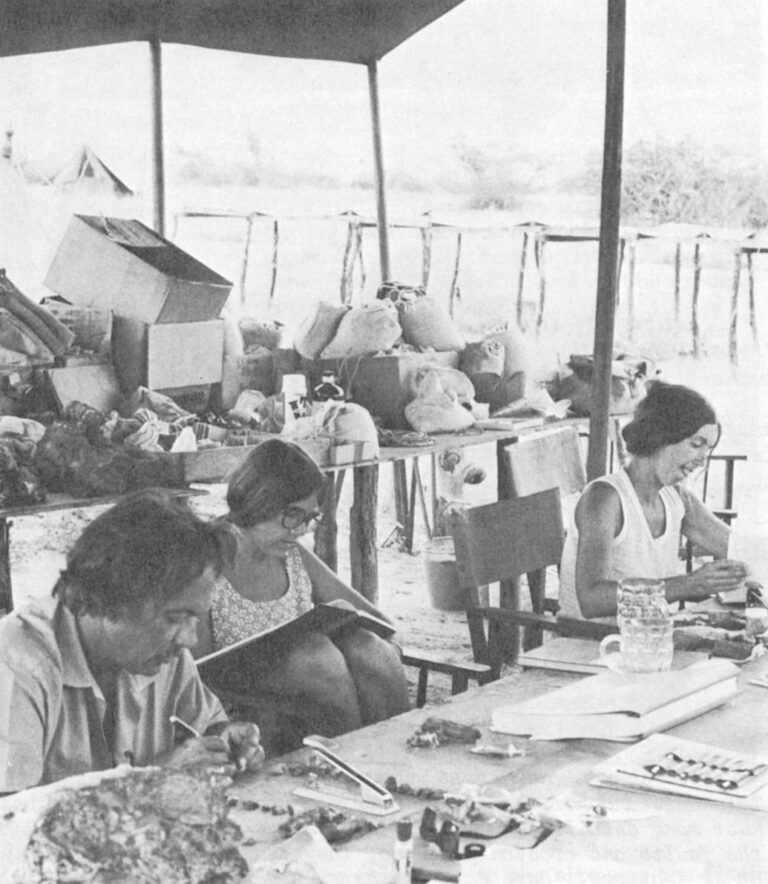
Most afternoons Clark Howell (l.) identifies and catalogs the fossils found that morning. In the shade of the “work tent” he numbers a fossil fragment while Dorothy Dechant, a student, records the information. Joan Merrick (r.) catalogs the artifacts recovered from her husband’s dig.
Such finds are not common in the Omo or anywhere else. More typically each member of the expedition spends his day working on his own line of scientific investigation, doing more or less the same thing each day.
Some of the studies appear at first to be far removed from learning about man’s evolution. For example, there is Hank Wesselman, a full-bearded former Peace Corps volunteer in Nigeria who is hoping to get a doctorate in anthropology by finding fossilized rodent teeth in the Omo beds. Mice and rats are far from man’s evolutionary path but, as Wesselman explains enthusiastically, “they are terrific clues. Once we know what kind of rodents were living around the Omo River at a given time, we know a lot about the whole environment.”
The work is closely related to the broad goal of the Omo Expedition to discover the types of environments through which early man evolved. If Wesselman finds, for example, the teeth of something like a gerbil, a species known to prefer arid climates, then that is obviously evidence for the kind of climate that prevailed when the animal lived. If there are hominid fossils from the same level, then there is reason to believe that man’s ancestors in that time and place were adapted to dry, perhaps desertlike conditions.
Now a mouse’s tooth is little bigger than the head of a pin, and very few of the delicate structures can survive rolling along on the bottom of a river and subsequent burial under tons of sediment. Finding them is a slow and laborious task.
Every morning the 32-year-old scientist, sporting an ostrich feather in his hat, drives his LandRover down into the beds to pick and shovel out 12 plastic buckets of sedimentary deposits that he hopes contain “microfauna” fossils. After saturating the chunks of clay and sand with kerosene to loosen the individual particles, Wesselman and his African crew haul the buckets down to a clearing in the densely forested banks of the Omo, where river water is used to wash away the smaller obscuring particles.
To do this elsewhere scientists normally suspend the samples in a sieve in the river, letting the currents wash away the finer particles. Because the Omo River teems with 12- and 15-foot crocodiles, this is risky. Instead Wesselman uses a gasoline-powered pump to suck up the river water and spray it over the screened boxes on the bank. In minutes, all that remain are a f ew handfuls of gravel and, hopefully, a fossil tooth or two.
While his assistants washed the sediments one day recently, Wesselman sat on the river bank with a visitor and, as black and white colobus monkeys ran about high in the trees, he drifted into an expansive mood.
“You know,” he said, “it’s something. We’re sitting right here on the bank of the river where Australopithecus came to drink. This same river. They were all over here.” He waved an arm, pointing out through the clearing to the dry, almost barren land beyond where now there were only bones. “That’s something.”
After the gravel dries in the sun, Wesselman and his assistants put a few spoonfuls in small trays and pick through the bits with tweezers. Once in a while, there appears a tiny reddish or brownish shiny dot. It is a tooth of a rodent that died perhaps three million years ago or maybe of some other small mammal like a bat.
Out of some 60,000 pounds of sediments washed, sifted and sorted in the last two years, Wesselman has collected less than an ounce of tiny teeth. Still, there are enough from several different times within the Omo span that Wesselman says he will soon, after more study and thought, be able to describe some aspects of the world of early men.
Two other scientists, Harry V. Merrick and Noel T. Boaz, are in charge of the more typical ways of hunting for fossils and artifacts.
Within sight of each other, between Tuf f F (2.04 million years) and Tuf f G (1.93 million years), they supervise the day-to-day excavations that seek to uncover fossils and artifacts exactly as they were deposited and before they would be eroded out of the hillsides. Objects uncovered “in situ”, lying in relation to each other exactly as they were laid down, can reveal much more about conditions at the time than can objects that have been scattered. Several bones that once belonged to the same individual may become separated during erosion. An abundance of artifacts that, if found together in situ, might suggest the life style of the hominids who made them, could never yield that possible interpretation if they were scattered.
Merrick, who recently joined the anthropology faculty at Yale, has found what could be among the oldest objects manufactured by hominids – small irregular flakes and chips of quartz that could only have been produced by deliberately striking stones against each other. Their function is not clear but they might have served as knives or scrapers.

To the untrained eye these chunks of quartz, shown here at two-thirds actual size, look like ordinary rocks. But, consider these facts: they were dug out of sediments miles from any quartz deposits, scores of them were lying within a few feet of each other and virtually on one level and they have been chipped and flaked in a way that does not look like natural damage. They were found in two-million-year-old deposits from a time when Australopithecus was living in the Omo Valley. Many have sharp edges that could cut meat or hide. The scientists believe they are almost certainly tools made by “ape-men.”
The first clue to the site was the finding of artifacts eroding down the hillside. They seemed to be coming from a shallow layer just a few yards above. Figuring that more should still be inside the uneroded portion of the hill, Merrick and his crew dug a quick test trench a few feet into the slope. It confirmed the suspicion and it was decided that a full scale excavation would probably expose many artifacts in situ. Merrick’s crew set about removing the “overburden”, the artifact-barren hillside that buried the quartz flakes. This is simply an earthmoving operation. As the diggers approached the artifact layer, or horizon, they worked more carefully, stopping a few inches above it.
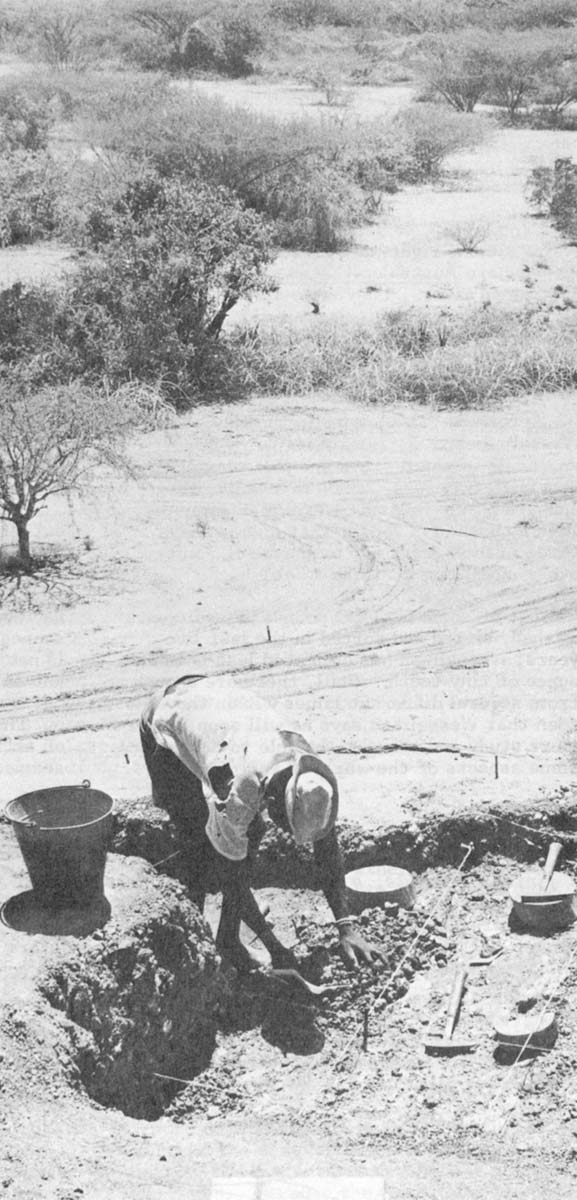
A little way up a slope of two-million-year-old sediments, workers have dug a notch into the hill to expose an undisturbed layer containing quartz artifacts. The flat land at the bottom of the hill is material that has eroded from the uplifted original layers. Only by digging into the still uneroded part of the hill can scientists find the tools of early man resting as they were dropped.
When about 100 square feet had been exposed, the area was marked off into one-meter squares with string stretched between nails driven at each corner. As more careful digging over succeeding days exposed the artifacts, the strings would help in mapping each one on paper with similar squares drawn to a reduced scale.
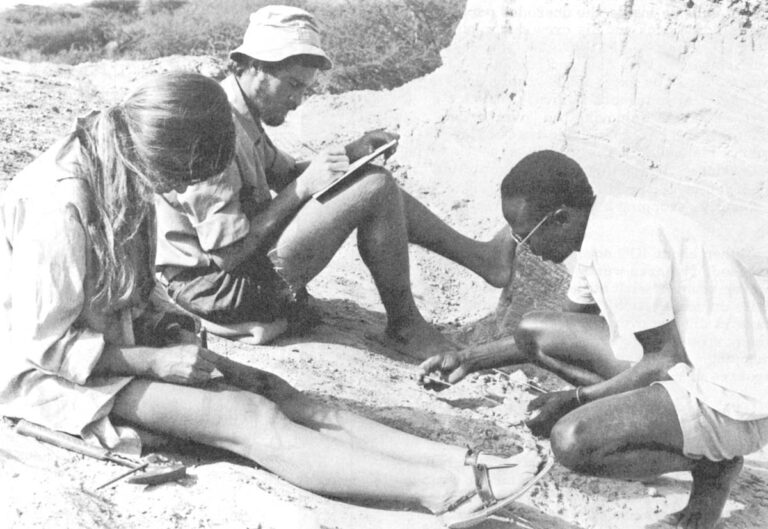
For weeks Merrick, assisted by his wife and half a dozen Wakamba, found dozens of artifacts, all of the same sort. As each piece emerged, its position was marked on the map and numbered. The artifact went into a small paper bag bearing the same number. The loose dirt was wheelbarrowed down the hill where more workers screened it for any tiny chips that might have been missed.
After the whole site had been excavated, the map would show any pattern in the distribution of artifacts. The numbers would help retrieve the exact bit of quartz for more detailed study of the technique used to make it.
Because of the relatively modest number of artifacts found, Merrick thought the site had probably not been a long-term living area but probably only a temporary campsite where a small band of hominids spent a few days before moving on.
Across the valley floor and part way up another hill is Locality 398 where Noel Boaz, a 22-year-old doctoral student at Berkeley, has spent much of the summer excavating what appears to have been a stream bed where hundreds of bones of many species came to rest some two million years ago. Using much the same techniques as the artifact hunters across the way, Boaz and his crew were collecting the remains of a wide variety of animals that, because they were all lying together on the same level, were probably members of the same ancient biological community. Unless the stream carried some of the bones from very far upstream, it is likely that the animals were living in roughly the same place at the same time. This information is enormously useful in reconstructing the habitats that existed at specific times.
To get to the fossil layer half a dozen men with gasoline-powered jackhammers, picks and shovels had worked two weeks earlier in the season to remove nearly 400 tons of overburden.
One day this past August Boaz and his dozen assistants were working at their usual tasks. Some men were digging to expose new areas of fossils. Others were gently cleaning away the sediments from the top half of fossil bones, leaving them in place until Boaz and an assistant could map the precise locations. Three or four more were screening the excavated dirt for fossils that might have been missed. One man was carefully brushing and scraping away the dirt from what appeared to be a complete skull of an extinct crocodile.
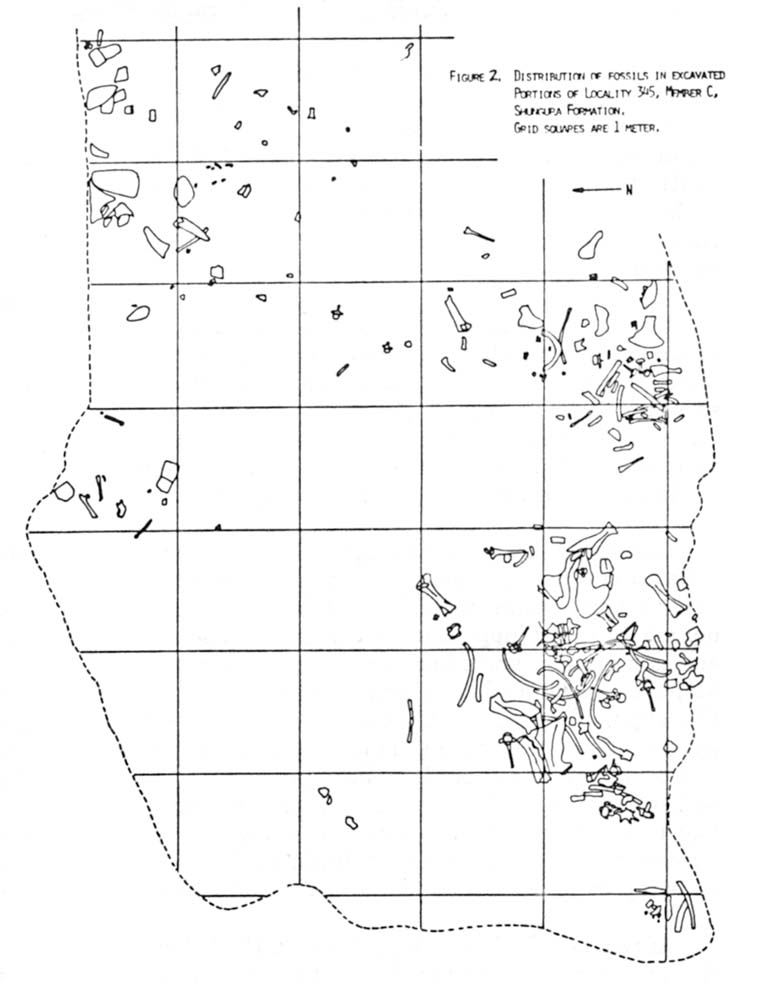
A finished map of a fossil excavation, showing the exact position of each bone as found. The cluster at the lower right comprises most of the skeleton of a single hippo. Other bones are those of three baboons, fish, crocodiles and turtles. The kinds of animals and the silt-sand deposits indicate that this was an aquatic environment. The undamaged bones and the nearly complete hippo suggest that it was quiet water, perhaps a pond, where fresh skeletons were not widely scattered. Such details help reconstruct ancient environments. These fossils are older than 2.56 million years.
It was getting towards noon and, in the heat, the usual singing and chanting of the Africans had begun to slow down. What had been complex three-part, responsive songs deteriorated into briefly murmured refrains. Then one of the men on the screen walked over to an excavator and showed him a little bit of thing in his hand. Some others gathered around, speculating on what it might be. Boaz, wearing only a beard and a pair of shorts and deeply tanned, looked up at the cluster. It was a piece of tooth.
“Monkey,” he guessed. “No,” insisted one of the workers, “it’s the first man.” When Boaz got a closer look, he concluded that it was indeed a hominid. It was assigned a number and went not into the usual bag but into Boaz’s pocket. As the routine work resumed, the African songs picked up tempo and volume. In the midst of the exotic words and rhythms could be heard a rather nicely chanted “Kyrie eleison, Christe eleison. “
At lunchtime Boaz and all his crew squeezed into a Land-Rover and drove back to the camp to eat. As Howell and the other scientists and some students took their seats under the mess tent, somebody said to Boaz, “Why don’t you show Clark?”
Boaz reached into his pocket and handed the molar fragment to Howell. “Nice,”Howell said. “Your first hominid?” Boaz grinned.
While much of the Omo Research Expedition’s effort is directed toward understanding the fauna of ancient times, a complete picture of early man’s environment must include knowledge of the flora. Was it grassland or forest? Were there plants with edible fruits? Were the plants those of a wet or dry climate, hot, medium or cold?
One clue is fossilized pollen, the microscopic grains of reproductive cells spewed out of ancient flowers and subsequently preserved like any other fossil. Because most plant species have characteristically shaped pollen grains, a look at the pollen under a microscope will usually reveal the species.
Dr. Raymonde Bonnefille, a geologist turned palynologist (fossil pollen expert) from the National Centre for Scientific Research in Paris, has spent three years in the Omo collecting sediment samples to see whether they contain pollen. Although it is widely believed that pollens do not preserve well in tropical environments, she has succeeded in extracting them from their sedimentary graves and in identifying several species. The work is slow and sometimes disappointing, however, because many samples yield no pollen at all.
One evening around the dinner table long after the sun had gone down and dry breezes made the 85-degree temperature seem much cooler, Bonnefille voiced her discouragement. Although there had been early successes in finding fossil pollens, results lately weren’t encouraging. Sample after sample was turning out to be devoid of pollen.
“I don’t want to put three years of my life into this and then have nothing to say at the end,” she confessed to Howell and Dr. Francis H. Brown, a geologist who also manages the expedition’s day-to-day affairs.
So little is known about fossil pollen, especially in tropical settings, that, like Bonnefille, most palynologists are still experimenting with new techniques. Nobody really knows what kind of deposits preserve pollens best, so many samples have to be taken from almost everywhere. Inevitably, most are barren.
Howell, Brown and Bonnefille spent most of an hour brainstorming new techniques to make it possible to test a wider range of samples quickly before proceeding with the time consuming definitive analysis. Thus samples that appear unlikely to yield results could be discarded early in the analysis.
Bonnefille gets her samples by climbing hills in the beds, looking for the geological strata that seem most favorable. Clad normally in a floppy hat, a clinging jersey and hot pants, she clambers up and down the slopes. With a pick or shovel she digs away the exposed surfaces that are contaminated with modern pollens and removes a hand- sized chunk of formerly buried, compacted sediments, quickly popping it into a plastic bag to avoid contamination. The bag is numbered and keyed to a geologic profile showing exactly where the sample came from.
After the field season, Bonnefille takes the samples back to her laboratory in Paris and treats them with an acid that dissolves away the sediments but leaves the pollen which is then examined under a microscope. In a few cases Bonnefille has found fossilized fruit dropped by ancient trees.
Although much work remains to be done in the lab, Bonnefille says she already sees evidence of a major transition in the type of vegetation in the Omo valley that took place just prior to about two million years ago. What had been a fairly wet climate, as indicated by the type of plants in the older deposits, became gradually drier. Denser bush and trees died out, giving way to open grasslands. There were hominids in the Omo valley during this time and the suggestion is strong that they would have had to change their ways to survive in the drier climate. It is just such major changes in environment that biologists believe open opportunities for newly evolved, better adapted creatures to survive and proliferate while the less able ones die out.
While the shape and size of the fossils, be they pollen grains or skulls, yields much information, little can be made of it without knowing how old the object is. De Heinzelin and Haesaerts can determine where a fossil comes from in the sequence of deposited layers, but still more work has to be done to say how old the layers are. For most of the career of the Omo Expedition this has been Frank Brown’s job. He is a geologist from the University of Utah and an expert in potassium-argon dating, one of the most reliable and widely used methods of determining how old fossil deposits are.
The method can be used wherever there are volcanic tuffs that contain lumps of pumice. Inside the pumice are often crystals that contained a certain amount of radioactive potassium when they were formed during the volcanic eruption. Ever since the eruption the potassium has been breaking down into argon gas at a known rate. Because the gas remains trapped within the crystal, Brown’s instruments can measure the amount of accumulated argon, compare it with the amount of potassium and determine how long the process has been going on or, in other words, how long ago the tuff was formed.
Despite the reliability of the technique, there is room for error and all paleontologists like to have their fossils dated by more than one method. If the two dates agree, the age can be accepted with greater confidence.
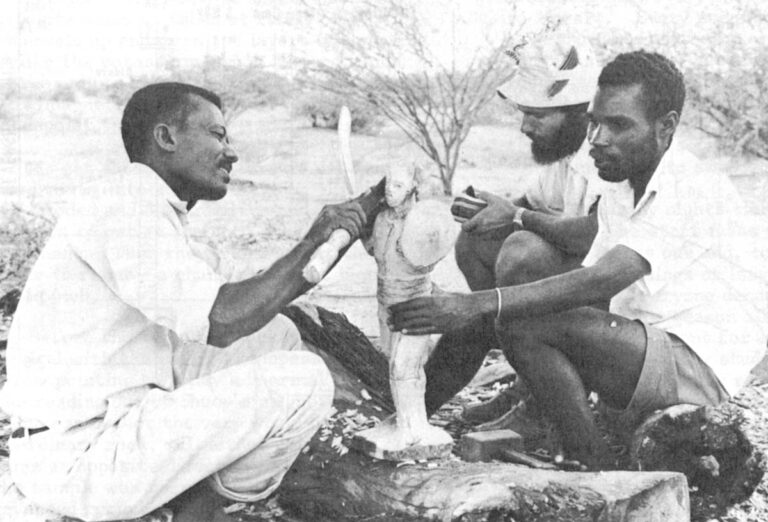
This season Brown brought Dr. Ralph Shuey, a colleague at Utah, into the field because he is an expert on a second kind of dating – based on determining the direction of magnetic polarity frozen into a rock shortly after it formed.
The technique capitalizes on the fact that at many times in the past the polarity of the earth’ s magnetic field has f lip-f lopped 180 degrees. Thus, for periods of varying duration in the past, today’s compass needle would have pointed to the South Pole. Sediments or tuffs formed during those times of reversed polarity oriented their own weakly magnetic particles in the same direction. Later, when the earth’s polarity returned to “normal” again, the particles in the older deposits had become too firmly compressed to re-orient themselves. They remained oriented in the “reversed” direction while the fresher, looser sediments above were still able to orient in line with the then prevailing “normal” polarity of the earth.
By taking samples at intervals up through a stack of layered sediments, Brown and Shuey can learn, after analysis in Brown’s Utah lab, which way the earth’s magnetic poles were oriented at the time of deposit. The Omo sequence of normals and reversals of various durations will be compared with the well dated deep sea cores (which were influenced by the same magnetism). If the Omo sequence matches that over a particular range of the deep sea cores, then the ages known for the cores can be taken as those of the matching Omo deposits.
While the technique is complex in its physics and in the interpretation of its findings, the field part of the method is simple drudgery.
Samples consisting of intact cubes of deposits must be taken at fairly close intervals up and down the layers of deposits. Unlike the potassium-argon method which works only on pumices, this method, called paleomagnetism, works on almost any kind of deposit that can yield a solid chunk.
To get their samples Brown and Shuey have to dig into a hillside, going through the eroded and disturbed material on the surface to get at the still uneroded sediment. Then they chip away at the layer to remove a chunk that is at least a cubic inch.
Before the sample is picked up, it is marked with the aid of a compass with an arrow pointing to today’s “normal” north. The reading out of Shuey’s magnetometer, which can detect the very weak magnetism in ordinary rock, will either point in the same or opposite direction, indicating that the sample was formed in a normal or reversed period.
During this season in the Omo Brown and Shuey took over 1,000 such samples from many parts of the Shungura Formation. By the end of this year, the magnetometer readings should be complete, confirming or refining the sequence of Omo valley dates and making the Omo one of the most accurately and reliably dated of all fossil man areas.
For all the hard work, the heat and the frustrations, life on the Omo has its little respites. The camp has a full staff of cooks and launderers. Gas-powered freezers make ice cubes. And portable tape recorders play everything from the Beatles to Mozart. Every evening, after the men have showered at the river (using the same pump that washes Wesselman’s gravels for rodent teeth), and the sun has retreated, Howell uncaps a bottle of scotch at his tent and people gather round to talk, sometimes to discuss scientific problems, sometimes just to swap stories.
On Saturday nights things are more festive. The staff mess tent is cleared, the beer comes out and, to the battery-powered recordings of Isaya Mwinanbo and his guitars, everyone dances. One Saturday night late in the season all the women in camp had left except for one, a pretty 22-year-old Berkeley student of Howell’s. Although the Wakamba readily dance solo, the camp’s only female hardly sat down the entire evening. Long about 11 p.m., when the party was dragging a bit, Howell ordered some more bottles of wine opened. Then Howell himself joined the dance, bobbing and stepping around the tent, in a kind of Omo River conga line of Africans.
Just outside the glare of the hissing gas lanterns, hardly noticed by the revelers, sat two Ethiopian soldiers with rifles. Elsewhere in the camp two more patrolled the area. The Ethiopian Government keeps them here throughout the field season to guard the camp from raids by tribesmen of the area.
Aside from that jarring reminder of the hostilities of men everywhere, the scientists of the Omo Research Expedition lead a remarkably peaceful and satisfying life, that is, as one of them said, “until we have to go back to the bureaucracy and power politics of the university.”
Received in New York on October 9, 1973.
©1973 Boyce Rensberger
Boyce Rensberger is an Alicia Patterson Foundation award winner with support from the L.S.B. Leakey Foundation. This article may be published with credit to Mr. Rensberger, the Alicia Patterson Foundation and the L.S.B. Leakey Foundation.

